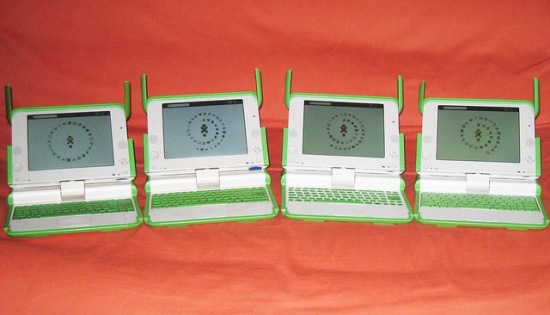Resumen en español al final del artículo

I got 2 XO-1.75s last week (the 2 on the right) so I now have all the production XOs and an opportunity to put them side by side with my original XO-1 (left) still kicking after 4 years of almost daily use and the very reliable and capable XO-1.5 (second from left)
Such a setting asks for comparisons. But let's start with the new kid on the block.
The ARM Admada 610 based XO-1.75 is impressive!
You can hardly tell the difference from the others when closed (only the 0 vs 3 vs 7 dots on the hinge can tell them apart), but the impressive part for me is that you can hardly tell that the XO-1.75 is an ARM machine when you use it. Good job Fedora/OLPC people!
The second impressive thing about the XO-1.75 is its real-life power consumption. Even at full CPU use (compiling) it can go 5 hours out of the same battery that hardly gives 2.5 hours on the XO-1, -1.5. At more normal use, 6+ hours is easily achievable and if you turn off the screen light (it's an XO after all) or you are outdoors were the XO-1.75 turns off the backlight automatically, can you get through the full work day!
When you open up the XO-1.75 you immediately notice the different keyboard. The old XO staple, membrane keyboard is now under a plastic frame that should decrease keyboard tear, a usual problem with this keyboard (though my 4-year old XO-1 does not support this...). The downside is that if you are older than 12-years old you have a fairly hard time typing on this keyboard. In contrast, the other XO-1.75 keyboard is an almost full size keyboard and with the exception of some "non-conventional" key placement is a pleasure to use. Unfortunately this keyboard is not a "party animal" since it hates eating and drinking. Hopefully will do well on the hands of teenagers and older, that is aimed at.
Performance wise, although the software is not the same for the x86-based XO-1 and XO-1.5 with the ARM-based XO-1.75, it feels in par with the very adequate XO-1.5 and far better that the XO-1.
So overall the XO-1.75 is a big step forward and suggests that the upcoming XO-3 is not only going to be produced but that will probably be a very nice tablet in many aspects.
Software Comparison
My 6 XOs (2 of each kind) also provide a chance to test the different versions of the software side-by-side. The "stable" Fedora 14/Sugar 0.94 and the "development" Fedora 17/Sugar 0.96 (os9) OLPC builds.
On the XO-1 the F17/S96 is really struggling. From performance and power management to size and collaboration. Of course 12.1.0 builds are still in development but I'm afraid the F14/S94 will remain the best OLPC OS version for the XO-1. Considering that XO-1 is out of production more than a couple of years now and that F14/S94 are very nice builds, I do not think that this is a problem.
On the XO-1.75 the F17/S96 combination is better that the F13-14/S94 builds even if they are "development" builds. It only makes sense since this is the future and the focus of the OLPC team is on these exact builds and hardware. I'm sure that they are going to get better with each consecutive release.
On the XO-1.5 the jury is still out. The F17/S96 builds still have some bugs and regressions compared to the stable F14/S94 builds, are a bit heavier and a bit unpolished, especially on the Gnome site. But they are still development builds, so things are only going to improve and hopefully surpass the current stable builds.
Resumen en español:


Very good side by side comparison.
Where in the world did you get all these laptops? I'm struggling just to find 1 laptop for sale within a reasonable price range. Impressive that you got them all, let alone 2 of each!
You may want to look at http://wiki.laptop.org/go/Contributors_program
If your *reason* of needing one or more laptops is deemed interesting/worthy you get them for free.